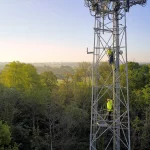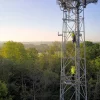ISP Sky Broadband Sees UK Data Traffic Climb to 8 Terabits per second
Customers on Sky Broadband’s UK network (around 6 million of them) are today generating a colossal level of internet data traffic that has already reached a total of around 8Tbps (Terabits per second). Meanwhile IPv6 adoption among the ISP’s subscriber base is at 90%+.
Sky are currently in the process of upgrading their core network in order to support an expectation of “massive” Video-on-Demand (VoD) growth, which not only stems from Sky’s own TV / IPTV services but also other platforms like Netflix, NOW TV (Sky), Amazon Prime Video and so forth.
As part of that Tim Rossiter, Sky’s Core Network Architect (Sky Network Services), has revealed some details about their progress during a meeting of the UK Network Operators’ Forum (UKNOF) and you can access the related slides here.
Advertisement
The slides are quite technical and will probably only be of use to those with an interest in the networking field, although they do reveal a few interesting bits of information about Sky’s approach. For example, in 2005 their core network made use of Cisco’s CRS1 routers with a => 640Gb chassis, while today they’re adding Cisco NCS5516 routers that can handle 55Tb per chassis (16 Slots, 3.6Tb per slot). The upgrade is taking place gradually and their Birmingham centre is the first to benefit. By the end of 2019 Sky expects to be handling around 16Tbps+ of total traffic.
Elsewhere we also got a short update on the progress of Sky Broadband’s IPv6 deployment to subscribers. Readers may recall that in 2016 Sky became the first major UK broadband ISP to rollout IPv6 across their network and they’ve recently been followed by BT, while Virgin Media is expected to join them this year and TalkTalk remain eerily quiet on the subject.
Sky states that over 5 Million of their customers are now eligible and enabled for IPv6, including all of their Sky Hub routers and their older legacy Sky-supplied Sagem kit. However actual uptake is running slightly behind at over 90%, which the ISP attributes to a combination of some customers choosing to disable IPv6, as well as some issues with the use of third-party or very old routers that may not fully support IPv6.
Mark is a professional technology writer, IT consultant and computer engineer from Dorset (England), he also founded ISPreview in 1999 and enjoys analysing the latest telecoms and broadband developments. Find me on X (Twitter), Mastodon, Facebook, BlueSky, Threads.net and Linkedin.
« Cityfibre and Vodafone Name First UK City for 1Gbps Home Broadband UPDATE

















































Comments are closed